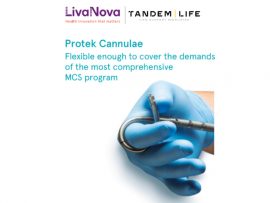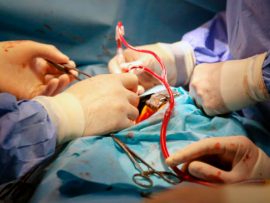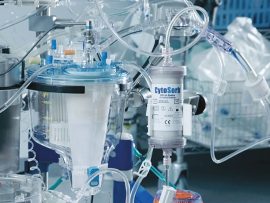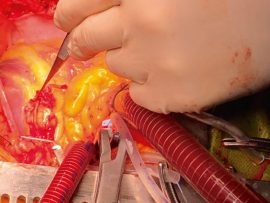Abstract There has been a significant increase in the use of short-term percutaneous ventricular assist devices (pVADs) as acute circulatory support in cardiogenic shock and to provide haemodynamic support during..
Read MoreAbstract OBJECTIVES Dual-lumen cannulas for veno-venous (VV) extracorporeal membrane oxygenation (ECMO) support are typically inserted in the right internal jugular vein (RIJV); however, some scenarios can make this venous route..
Read MoreAbstract Introduction Venovenous extracorporeal membrane oxygenation (VV ECMO) is used for refractory hypoxemia, although despite this, in high cardiac output states, hypoxaemia may persist. The administration of beta-blockers has been..
Read MoreAbstract Objectives Although cardiogenic shock requiring extracorporeal life support after cardiac surgery is associated with high mortality, the impact of sex on outcomes of postcardiotomy extracorporeal life support remains unclear..
Read MoreAbstract Background Women are at higher risk of mortality from many acute cardiovascular conditions, but studies have demonstrated differing findings regarding the mortality of cardiogenic shock in women and men...
Read MoreAbstract Objectives To estimate whether the association of transfusion and acute kidney injury (AKI) has a threshold of oxygen delivery below which transfusion is beneficial but above which it is..
Read MoreAbstract In 1900, Fiedler first reported autopsy cases with peculiar inflammation of the myocardium, which he named interstitial myocarditis. He postulated an isolated cardiac inflammation of the myocardium in the..
Read MoreAbstract Background Red blood cell (RBC) transfusions are frequent in patients after cardiac surgery. This study assessed whether a bundle of care including pre-operative and post-operative administration of (EPO) with intravenous..
Read MoreAbstract Background It is common for patients on venovenous extracorporeal membrane oxygenation (VV ECMO) to require continuous renal replacement therapy (CRRT). This can be done using separate vascular access for..
Read MoreAbstract Background A left thoracotomy approach is anatomically appropriate for childhood aortic coarctation; however, the pediatric femoral arteriovenous diameters are too small for cardiopulmonary bypass cannulation. We aimed to determine..
Read MoreAbstract Background Platelets stored at 1–6 °C are hypothesized to be more hemostatically active than standard room temperature platelets (RTP) stored at 20–24 °C. Recent studies suggest converting RTP to cold-stored platelets..
Read MoreAbstract Background: Antithrombin (AT) replacement is occasionally utilized in the setting of extracorporeal membrane oxygenation (ECMO)-associated heparin resistance. Although past studies emphasized the high costs and limited clinical benefit..
Read MoreAbstract Background Risk-stratifying patients with (CS) is a major unmet need. The recently proposed Society for Cardiovascular and Interventions (SCAI) staging system for CS severity lacks uniform criteria defining each stage. Objectives..
Read MoreAbstract DESPITE MEDICAL ADVANCEMENTS, mortality in cardiogenic shock (CS) remains unacceptably high.The decreased cardiac output resulting in impaired oxygen delivery characteristic of CS triggers a dismal cascade culminating in tissue..
Read MoreAbstract Introduction Limited evidence exists on the distribution of ABO RhD blood groups and prevalence and specificity of red blood cell (RBC) alloantibodies in Aboriginal and Torres Strait Islander peoples..
Read MoreA precise blood transfusion evaluation model for aortic surgery: a single-center retrospective study
Abstract Cardiac aortic surgery is an extremely complicated procedure that often requires large volume blood transfusions during the operation. Currently, it is not possible to accurately estimate the intraoperative blood..
Read MoreAbstract Acute kidney injury (AKI) is a complex and life-threatening condition with multifactorial etiologies, ranging from ischemic injury to nephrotoxic exposures. Management is founded on treating the underlying cause of..
Read MoreAbstract Background: Venovenous extracorporeal membrane oxygenation (VV-ECMO) is a therapy for patients with refractory respiratory failure. The decision to decannulate someone from extracorporeal membrane oxygenation (ECMO) often involves weaning trials..
Read MoreAbstract The usage of cardiopulmonary bypass (CPB) in cardiothoracic surgery contributes to the activation of the inflammatory response. In certain cases, the systemic inflammatory response may be immoderate, leading to..
Read MoreAbstract Objectives To compare the outcomes of factor eight inhibitor bypassing activity (FEIBA) versus fresh frozen plasma (FFP) as the primary treatment for postoperative coagulopathy in patients undergoing cardiac surgery...
Read MoreAbstract Background: Post-cardiotomy cardiogenic shock (PCCS) remains a life-threatening complication after cardiac surgery. Extracorporeal membrane oxygenation (ECMO) represents the mainstay of mechanical circulatory support for PCCS; however, its availability..
Read MoreAbstract Study Objective To determine the association of practitioner dashboard feedback of intraoperative and temperature control on maintenance of and normothermia. Design Retrospective review. Setting Single institution. Patients Patients over the age of..
Read MoreAbstract Unfractionated heparin (UFH) and its low-molecular-weight fragments (LMWH) are widely used as anticoagulants for surgical procedures and extracorporeal blood purification therapies such as cardiovascular surgery and dialysis. The anticoagulant..
Read MoreAbstract Objective: Conventional mock circulatory loops (MCLs) cannot replicate realistic hemodynamic conditions without inducing blood trauma. This constrains in-vitro hemocompatibility examinations of blood pumps to static test loops that do..
Read MoreAbstract Objective The initiation of extracorporeal membrane oxygenation (ECMO) triggers complex coagulation processes necessitating systemic anticoagulation. Therefore, anticoagulation monitoring is crucial to avoid adverse events such as thrombosis and hemorrhage...
Read MoreAbstract BACKGROUND The impact of sex-differences on the release of cardiac biomarkers after coronary artery bypass grafting (CABG) remains unknown. The aim of our study was to (a) investigate the..
Read MoreAbstract Objectives Patient safety incident reporting in our institution’s intensive care units (ICUs) had fallen 30% below national benchmarks during the COVID-19 pandemic. Underreporting diminishes awareness of risks and precludes..
Read MoreAbstract Postoperative mortality accounts for 7.7% of all global deaths, while postoperative complications increase 1-year mortality by 60%. Risk prediction models for postoperative complications and mortality can facilitate tailored risk..
Read MoreAbstract Purpose After cardiac surgery, fluid bolus therapy (FBT) with 20% human albumin may facilitate less fluid and vasopressor administration than FBT with crystalloids. We aimed to determine whether, after..
Read MoreAbstract JEHOVAH'S WITNESSES (JW) refuse allogeneic blood transfusions because of their religious beliefs, a situation that poses significant challenges in the context of cardiac surgery, given that bleeding-related complications may..
Read More






















